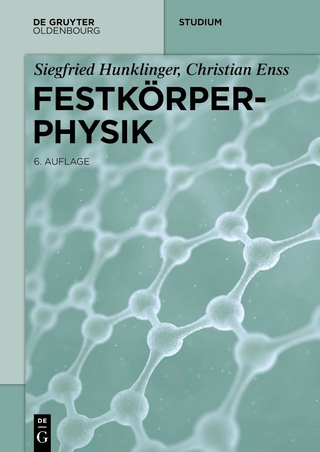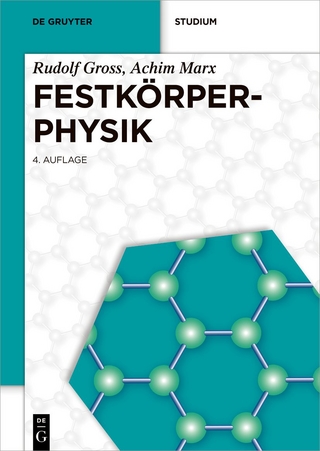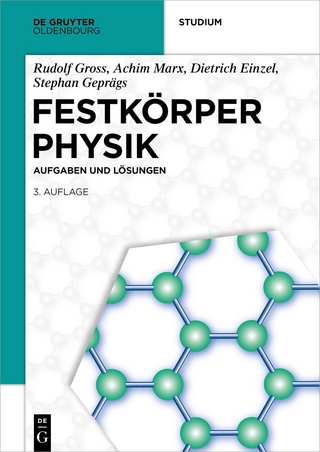
Semiconductor Nanophotonics
Oxford University Press (Verlag)
978-0-19-878469-2 (ISBN)
Nanometre sized structures made of semiconductors, insulators, and metals and grown by modern growth technologies or by chemical synthesis exhibit novel electronic and optical phenomena due to the confinement of electrons and photons. Strong interactions between electrons and photons in narrow regions lead to inhibited spontaneous emission, thresholdless laser operation, and Bose-Einstein condensation of exciton-polaritons in microcavities. Generation of sub-wavelength radiation by surface plasmon-polaritons at metal-semiconductor interfaces, creation of photonic band gaps in dielectrics, and realization of nanometer sized semiconductor or insulator structures with negative permittivity and permeability, known as metamaterials, are further examples in the area of Nanophotonics. The studies help develop spasers and plasmonic nanolasers of subwavelength dimensions, paving the way to use plasmonics in future data centres and high-speed computers working at THz bandwidth with less than a few fJ/bit dissipation.
The present book is aimed at graduate students and researchers providing them with an introductory textbook on Semiconductor Nanophotonics. It gives an introduction to electron-photon interactions in Quantum Wells, Wires, and Dots and then discusses the processes in microcavities, photonic band gap materials, metamaterials, and related applications. The phenomena and device applications under strong light-matter interactions are discussed, mostly by using classical and semi-classical theories. Numerous examples and problems accompany each chapter.
Prasanta Kumar Basu (B.Sc honours in Physics), B. Tech, M.Tech and Ph.D. (all in Radio Physics and Electronics) joined the RPE department of Calcutta University as a Lecturer in 1971. His research has been in semiconductors. He is an Alexander von Humboldt fellow and he also worked as Visiting Professors in McMaster University, Canada, National Chung Cheng University, Taiwan, and TIFR, India. He was in several administrative positions in RPE department. After his retirement from CU in 2011, he worked as a UGB BSR Faculty fellow, then as Visiting Professor in IIT Kharagpur and finally as an investigator in a joint Indo Taiwan project. Since 2019, he is engaged in honorary collaborative research and book writing in RPE department. Bratati Mukhopadhyay received the B.Sc (Hons in Physics)., B.Tech., M.Tech., and Ph.D. degrees from the University of Calcutta, Kolkata, India, in 1994, 1997, 1999, and 2007, respectively. She joined Institute of Radio Physics and Electronics, CU, as a Lecturer in 2008. Her research area includes Group IV photonics, transport and scattering in semiconductor nanostructures, nanoscale FETs, etc. In addition, she is one of the authors of a book “Semiconductor Laser Theory” (CRC Press, 2015). She teaches CMOS analog circuit, VLSI design, guidedwave photonics, and photonic devices, in addition to semiconductor related subjects. She also supervises a number of B.Tech. and M.Tech. projects and guides several Ph.D. students. Rikmantra Basu (B.Sc honours in Physics), B. Tech (IT), M.Tech (RPE) and Ph.D. (CUNN) all from Calcutta University joined as an Assistant Professor in the ECE department of BITS Pilani in 2013 and then in the ECE department of NIT Delhi in 2014. His research is in Semiconductor photonic devices, Group IV photonics and plasmonics, sensors at mid IR using GeSn alloys, and biosensors on graphene. He is the recipient of URSI Young Scientist award and he worked as visiting Scientist in Bristol University, UK and National Chung Cheng University, Taiwan. He has guided and is guiding several M. Tech and Ph.D. students.
Preface
Acknowledgements
Chapter 1: Introduction
1.1: Introduction to Nanophotonics
1.2: Nanophotonics : Scope
1.3: Introduction to Nanostructures
1.4: Novel Phenomena in Nanophotonics: A Brief Outline
1.5: Applications of Nanophotonics
1.6: Problems of Integration
Chapter 2: Basic Properties of Semiconductors
2.1: Introduction
2.2: Band Structure
2.3: Density of States
2.4: Doping
2.5: Carrier Concentration
2.6: Carrier Concentration
2.7: Excess Carriers and Recombination
2.8: Excitons
2.9: Alloys and Heterojunctions
2.10: Quantum Structures
2.11: Strained Layers
Chapter 3: Macroscopic Theory of Optical Processes
3.1: Introduction
3.2: Optical Constants
3.3: Phase and Group Velocities
3.4: Susceptibility of a Material: a Classical Model
3.5: Einstein's Model for Light-Matter Interaction
Chapter 4: Photons and Electron-photon Interactions
4.1: Introduction
4.2: Wave Equation in a Rectangular Cavity
4.3: Quantization of the Radiation Field
4.4: Time Dependent Perturbation Theory
4.5: Interaction of an Electron with the Electromagnetic Field
4.6: Second Order Perturbation Theory
Chapter 5: Electron Photon Interactions in Bulk Semiconductors
5.1: Introduction
5.2: Absorption Processes in Semiconductors
5.3: Fundamental Absorption in Direct gap
5.4: Intervalence Band Absorption
5.5: Free Carrier Absorption
5.6: Recombination and Luminescence
5.7: NonradiativeRecombination
5.8: Carrier Effect on Absorption and Refractive Index
5.9: Gain in Semiconductors
Chapter 6: Optical Processes in QWs
6.1: Introduction
6.2: Optical Processes in QWs
6.3: Interband Absorption
6.4: Intersubband Absorption
6.5: Recombination in QWs
6.6: Loss Processes in QWs
6.7: Gain in QWs
6.8: Strained QW Lasers
Chapter 7: Excitons in Bulk Semiconductors and QWs
7.1: Introduction
7.2: Excitons in Bulk Semiconductors
7.3: Excitonic Processes in QWs
7.4: Line Broadening Mechanisms for 2D Excitons
7.5: Effect of Electric Field in Semiconductors
7.6: Excitonic Characteristics in Fractional Dimensional Space
Chapter 8: Nanowires
8.1: Introduction
8.2: Quantum Wires: Preliminaries
8.3: Excitonic Processes in QWRs
8.4: Classification of Nanowires
8.5: Growth of QWRs
8.6: Nanowires
8.7: Properties of NWRs
8.8: Applications of NWRs
Chapter 9: Nanoparticles
9.1: Introduction
9.2: Quantum Dots
9.3: QD Growth Mechanisms and Structures
9.4: Zero Dimensional Systems
9.5: Deviation from Simple Theory: Effect of Broadening
9.6: QD Lasers : Structure and Gain Calculation
9.7: Intersubband Transitions
9.8: Excitonic Processes in QDs
9.9: Classification of Nanocrystals
9.10: Synthesis of Nanocrystals
9.11: Core-Shell Structures
9.12: Bright and Dark Excitons
9.13: Biexcitons and Trions
9.14: Applications
Chapter 10: Microcavity
10.1: Introduction
10.2: Cavity Fundamentals
10.3: Fabry-Perot Resonators
10.4: Bragg Gratings and Bragg Mirrors
10.5: Ring Resonators
10.6: Whispering Gallery Mode Resonators
10.7: Wave Propagation in Periodic Structures: Photonic Crystals
10.8: Micropillar
10.9: Characteristics of Microcavity
Chapter 11: Cavity Quantum Elecrodynamics
11.1: Introduction
11.2: Zero-Point Energy and Vacuum Field
11.3: Control of Spontaneous Emission
11.4: Mode Density in Ideal Cavities
11.5: Experimental Observation of Purcell Effect
11.6: Strong Light-Matter Coupling
11.7: Jaynes-Cummins Model
11.8: Microcavities in CQED Experiments
11.9: Applications
11.10: Microcavity Laser
Chapter 12: Bose Einstein Condensation
12.1: Introduction
12.2: Elements of Bose Einstein Condensation
12.3: BEC in Semiconductors
12.4: Bulk Excitons
12.5: Indirect Excitons in Coupled QWs
12.6: Polariton
12.7: Polariton Lasers
12.8: Modeling of Electrically Driven Polariton Laser
Chapter 13: Surface Plasmons
13.1: Introduction
13.2: Basic Concepts
13.3: Surface Plasmon Polaritons at Metal/Insulator Interfaces
13.4: Excitation Mechanism
13.5: Materials
13.6: Length Scales in Noble Metals
13.7: Metal-insulator Based Plasmonics-photonics
13.8: All Semiconductor Plasmonics
13.9: Plasmonic Properties of Semiconductors
13.10: Components: source, modulators, waveguides, detector
13.11: Application of Plasmonics in VLSI, Data Centres and Supercomputers
13.12: Applications of Surface Plasmons in Basic Science and Characterization
13.13: Intersubband Plasmons
Chapter 14: Spasers and Plasmonic Nanolasers
14.1: Introduction
14.2: Early Investigations on SP Amplification
14.3: Models for Noginov et al Experiment
14.4: Semiconductor Spasers and Plasmonic Nanolasers
14.5: Theoretical Models by Khurgin and Sun
14.6: Current Theoretical Models and Experiments
14.7: Further Developments
Chapter 15: Optical Metamaterials
15.1: Introduction
15.2: Left Handed Material with Negative RI
15.3: Structures for Microwaves
15.4: Perfect Lens
15.5: NIR with Positive Permittivity and Permeability
15.6: Low Loss Plasmonic Metamaterial
15.7: Semiconductor Metamaterials
15.8: Metasurfaces
15.9: Beam Steering
Chapter 16: Nanolasers
16.1: Introduction
16.2: Parameters of Lasers
16.3: Progress in Nanolasers
16.4: Threshold Pump Power of Nanolasers: Purcell Effect
16.5: Intrinsic Merit of Nanolasers
16.6: Optical Interconnect
16.7: Metal Based Nanolasers
| Erscheinungsdatum | 07.04.2022 |
|---|---|
| Reihe/Serie | Series on Semiconductor Science and Technology ; 26 |
| Zusatzinfo | 174 line drawings and halftones |
| Verlagsort | Oxford |
| Sprache | englisch |
| Maße | 177 x 253 mm |
| Gewicht | 1278 g |
| Themenwelt | Naturwissenschaften ► Physik / Astronomie ► Festkörperphysik |
| Naturwissenschaften ► Physik / Astronomie ► Optik | |
| Technik ► Elektrotechnik / Energietechnik | |
| ISBN-10 | 0-19-878469-4 / 0198784694 |
| ISBN-13 | 978-0-19-878469-2 / 9780198784692 |
| Zustand | Neuware |
| Haben Sie eine Frage zum Produkt? |
aus dem Bereich


